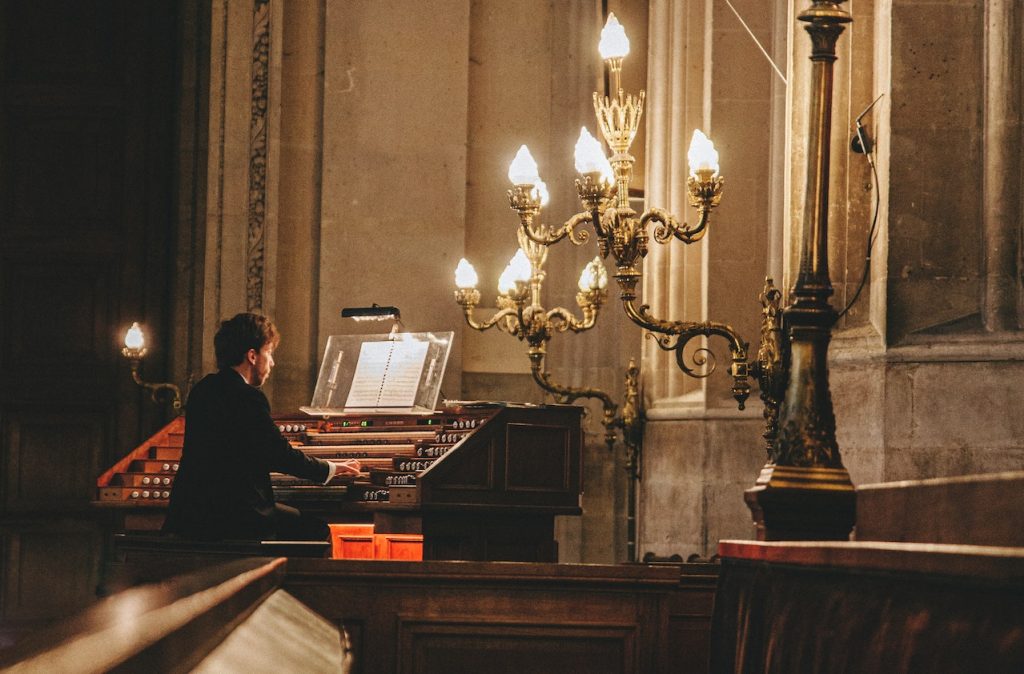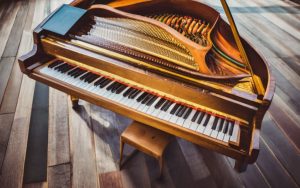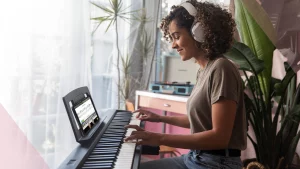In the world of music, few debates are as timeless as the organ vs. the piano. Both instruments, with their rich histories and distinct sounds, have charmed audiences for centuries. But for someone standing at the crossroads of learning, the choice isn’t always clear-cut.
Whether you’re a budding musician or someone looking to rekindle a long-lost passion, this guide dives deep into the nuances of both instruments. From their historical roots to practical considerations, we’ll explore every facet to help you make an informed decision. So, let’s strike a chord and unravel the musical mystery of the organ and piano.

Historical background
Ever found yourself at the crossroads of choosing between the organ and the piano? Before you make a decision, let’s embark on a musical journey through time. Understanding the rich history of these instruments might just sway your choice. Ready? Let’s hit the keys!
The organ’s historical journey
The organ, often dubbed the “King of Instruments,” has a majestic history that dates back to ancient Greece. Its origins trace back to the hydraulis, a water-powered instrument. Over the centuries, the organ evolved, adopting air bellows and expanding its range.
Origins and evolution
The organ’s journey began with the Greeks, but it was during the medieval period that it found its place in churches. Its grandeur and ability to produce a wide range of volumes made it a favorite for religious ceremonies.
Famous composers and pieces
Johann Sebastian Bach, often considered the master of organ music, gave us pieces like Toccata and Fugue in D minor. César Franck and Olivier Messiaen also contributed significantly to the organ repertoire. If you’ve ever felt goosebumps during a movie climax, thank the organ’s dramatic flair, often used in film scores.
The piano’s evolutionary tale
Ah, the piano! A more recent invention than the organ but no less significant. Its name, derived from the Italian pianoforte, hints at its dynamic range: soft (piano) to loud (forte).
Its inception and transformation
The piano was born in the early 18th century, thanks to Bartolomeo Cristofori of Italy. Unlike its stringed predecessors like the harpsichord, the piano allowed for dynamic expression, which was revolutionary. This distinction between the harpsichord and the piano is a key point in the “harpsichord vs piano” debate. Over the years, the piano underwent various transformations – from the fortepiano of Mozart’s time to the modern grands we see on concert stages today.
Iconic pianists and their contributions
Frédéric Chopin, the “Poet of the Piano,” gave us nocturnes and ballades that still resonate today. Then there’s Ludwig van Beethoven, whose Moonlight Sonata remains a favorite among many. Modern legends like Lang Lang continue to shape the piano’s legacy, bridging classical traditions with contemporary appeal.
Physical differences
When it comes to the organ and piano, their distinct sounds aren’t the only differences. A closer look reveals contrasting designs and mechanics that make each instrument unique. Let’s dive into the anatomy of these musical marvels, shall we?
Organ’s anatomy and design
The organ, with its towering pipes and multiple keyboards, is a sight to behold. But its grandeur isn’t just for show; every part has a purpose.
Description of the organ’s structure
At first glance, the organ might seem overwhelming with its array of pipes, ranging from pencil-thin to several feet wide. These pipes are organized into ranks and controlled by stops, allowing the organist to choose different sounds.
Key components and their functions:
- Manuals: These are the keyboards of the organ. Larger organs can have up to five manuals!
- Pedalboard: Played with the feet, this keyboard adds depth to the organ’s sound.
- Stops: These control which ranks of pipes are active. Ever heard the phrase “pulling out all the stops”? It originates from here, meaning to use all available resources.
- Bellows: These provide the wind needed to produce sound. In older organs, they were manually operated!
Inside the piano framework
The piano, often seen as the organ’s more compact cousin, has its own intricate design that’s a marvel of engineering and craftsmanship.
Anatomy of a piano
A wooden frame houses strings of varying lengths and thicknesses. When a key is pressed, a hammer strikes the corresponding strings, producing sound. The number of strings varies, with most modern pianos having over 200!
How the sound is produced:
- Keys and hammers: Press a key, and its corresponding hammer strikes a string. The force of the strike determines the volume.
- Strings: These are made of steel (for higher notes) and copper-wound steel (for lower notes). Their vibration produces sound.
- Soundboard: This wooden piece amplifies the vibrations from the strings, enriching the sound.
- Pedals: The piano typically has three: soft pedal (quieter sound), sostenuto (sustains selected notes), and damper (sustains all notes).
Sound and technique
The soul of any musical instrument lies in its sound and the techniques used to produce it.
While the organ and piano may share some similarities, their tonal characteristics and playing methods set them apart. Let’s delve into the auditory world of these instruments and uncover the techniques that bring their sounds to life.
Organ’s sound characteristics
The organ, often associated with grand cathedrals and solemn ceremonies, has a sound that can be both powerful and ethereal.
The unique sound of the organ
The organ’s sound is vast and resonant, capable of filling large spaces with its majestic tones. From the softest whisper to a thunderous roar, its range is unparalleled. The combination of different stops and ranks allows for a myriad of tonal possibilities, from flute-like sounds to trumpet blasts.
Basic techniques for playing:
- Registration: This involves selecting the right combination of stops to achieve the desired sound. It’s an art in itself!
- Articulation: Given that organ keys don’t respond to velocity like piano keys, articulation (how notes are connected or separated) is crucial.
- Pedal technique: Playing the pedalboard requires coordination and practice. Proper footwork can add depth and complexity to the music.
Piano’s sound profile
The piano, beloved by many, offers a sound that is versatile and expressive, making it a favorite across various music genres.
The rich tones of the piano
The piano’s sound is dynamic and expressive. Its tones can be soft and melodic or powerful and percussive. The ability to play multiple notes simultaneously allows for rich harmonies and intricate melodies.
Fundamental techniques for beginners:
- Finger positioning: Proper hand and finger positioning is the foundation of good piano playing.
- Dynamics: This refers to the loudness or softness of the music. By varying the force of key presses, pianists can convey emotions and add depth to their performance.
- Pedaling: The use of pedals can sustain notes, soften the sound, or create varied effects. Mastering pedaling can elevate a performance.
Learning curve
Every musical instrument presents its own set of challenges and rewards. The journey of mastering an instrument is filled with highs and lows, moments of clarity, and bouts of frustration. But as with any skill, persistence and the right guidance can make all the difference.
Let’s explore the learning curves of the organ and piano, and what you can expect as you embark on these musical adventures.
Mastering the organ
The organ, with its multiple keyboards and pedals, can seem daunting to the uninitiated. But with dedication, the intricate dance of hands and feet becomes second nature.
Challenges faced by beginners:
- Coordination: Juggling between multiple manuals and the pedalboard requires both mental and physical coordination.
- Registration: Selecting the right combination of stops to achieve the desired sound can be overwhelming for newcomers.
- Sustained notes: Unlike the piano, organ notes can be sustained indefinitely, which requires a different approach to playing.
Time investment and practice routines:
- Consistency is key: Daily practice, even if short, can be more beneficial than sporadic longer sessions.
- Focused practice: Instead of playing through entire pieces, focus on challenging sections.
- Pedal practice: Dedicate separate practice time for the pedalboard to build foot agility and strength.
Piano learning path
The piano, while more familiar to many, has its own set of challenges. However, its intuitive design makes it a favorite starting point for many music enthusiasts.
Common hurdles for new learners:
- Hand independence: Playing different rhythms and melodies with each hand can be tricky initially.
- Dynamics: Achieving the right volume and emotion through key pressure takes practice.
- Reading sheet music: For those new to music, deciphering sheet music can feel like learning a new language.
Tips for effective practice:
- Slow and steady: Start by playing challenging sections slowly, then gradually increase the speed.
- Break it down: Divide pieces into smaller sections, mastering each before moving on.
- Use technology: Apps like Skoove can provide real-time feedback and interactive lessons.
Remember, every pianist or organist, no matter how accomplished, started as a beginner. With passion, persistence, and the right resources (like Skoove!), you’ll find joy and fulfillment in your musical journey.
Versatility and repertoire
The beauty of musical instruments lies not just in their sound, but in the vast array of music they can produce. Both the organ and the piano have rich histories that span various genres, cultures, and eras. Their versatility has allowed musicians to express a myriad of emotions and tell countless stories. Let’s dive into the diverse world of music that these instruments have to offer.
Organ
The organ has a sound that resonates with grandeur and majesty. Its powerful tones have graced many a cathedral and concert hall.
Genres and pieces best suited for the organ:
- Classical: From Bach’s Toccata and Fugue in D minor to Saint-Saëns’ Symphony No. 3, the organ has a storied classical repertoire.
- Sacred music: Hymns and chorales have been staples in churches for centuries.
- Jazz: Artists like Jimmy Smith have introduced the organ to the world of jazz, giving it a groovy twist.
Famous organ compositions:
- Bach’s Passacaglia and Fugue in C minor: A testament to Bach’s genius, this piece is a masterclass in variation and development.
- Widor’s Toccata from Symphony No. 5: A piece that showcases the organ’s agility and power.
Piano
The piano’s charm lies in its adaptability. From intimate ballads to grand concertos, its range is vast and varied.
The piano’s adaptability across genres:
- Classical: Beethoven, Chopin, and Liszt are just a few of the many composers who’ve contributed to the piano’s classical repertoire.
- Jazz: The likes of Duke Ellington and Thelonious Monk have used the piano to craft timeless jazz piano pieces.
- Pop and Rock: Modern artists, from Elton John to Alicia Keys, have showcased the piano’s relevance in contemporary music.
- Film Scores: The piano’s emotive tones have enhanced many cinematic moments.
Must-learn pieces for every pianist:
- Beethoven’s Moonlight Sonata: A piece that captures a spectrum of emotions.
- Debussy’s Clair de Lune: A gentle, impressionistic piece that evokes serene moonlit nights.
- Chopin’s Nocturnes: Perfect for those looking to delve into romantic music.
For those eager to explore these pieces and more, Skoove offers a diverse range of lessons spanning genres and skill levels. Whether you’re a budding pianist or an organ enthusiast, Skoove’s interactive lessons and expert teachers can guide you on your musical journey. Dive in and discover the world of music at your fingertips!
Practical considerations
Choosing between the organ and the piano isn’t just about the music; it’s also about the practicalities. From initial costs to space requirements, there are several factors to consider before making an investment. Let’s break down some of the key considerations to help you make an informed decision.
Cost
Every musical journey starts with an investment, and understanding the costs associated with your chosen instrument is crucial.
Initial investment:
- Organ: A basic electronic organ can start from a few hundred dollars, but traditional pipe organs or high-end digital versions can run into the thousands.
- Piano: Upright pianos typically start at around $2,000, while grand pianos can range from $10,000 to well over $100,000 for concert grands.
Maintenance:
- Organ: Electronic organs require minimal maintenance, but traditional pipe organs need regular tuning and care.
- Piano: Requires tuning at least once a year. Other potential costs include voicing, regulation, and occasional repairs.
Space requirements
The size of your living space can greatly influence your instrument choice.
- Organ: Even a small electronic organ can take up a significant amount of space due to its multiple keyboards and pedalboard. Traditional pipe organs are usually reserved for churches or large halls.
- Piano: Upright pianos are more compact and suitable for smaller spaces, while grand pianos need a spacious room to resonate properly.
Portability
For those who perform or move frequently, the ease of transport is a key consideration.
- Organ: Electronic organs can be bulky but are generally more portable than traditional ones. Some models are designed specifically for easy transport.
- Piano: Upright pianos are heavy and challenging to move, while grand pianos are even more so. Digital pianos or keyboards offer a portable alternative.
Professional perspectives
- Organ: Many professionals highlight the organ’s ability to produce a vast range of sounds, making it suitable for solo performances or leading a congregation in a church setting.
- Piano: Professionals often praise the piano’s versatility, noting its suitability for solo performances, accompaniments, and ensemble work. Its widespread use across genres also offers broader career opportunities.
The final note: organ or piano?
In the grand symphony of life, both the organ and the piano have their unique melodies and harmonies. While the organ offers a rich tapestry of sounds and a deep historical resonance, the piano boasts versatility and a wide-ranging repertoire. Your choice between the two should resonate with your personal preferences, space, budget, and musical aspirations.
Remember, it’s not about which instrument is better, but which one strikes the right chord with you. Dive deep, explore both realms, and let your heart guide your fingers. Whatever you choose.
Author of this blog post:

Eddie Bond is a multi-instrumentalist performer, composer, and music instructor currently based in Seattle, Washington USA. He has performed extensively in the US, Canada, Argentina, and China, released over 40 albums, and has over a decade experience working with music students of all ages and ability levels.














